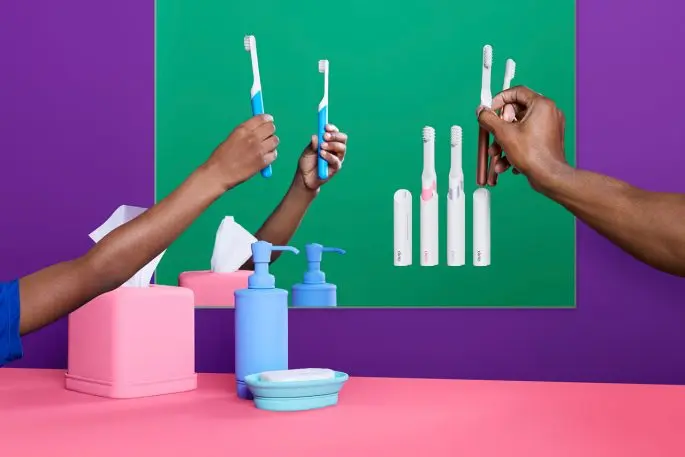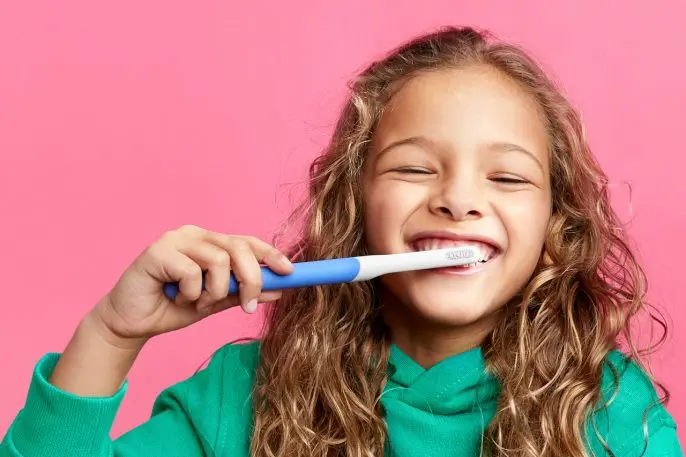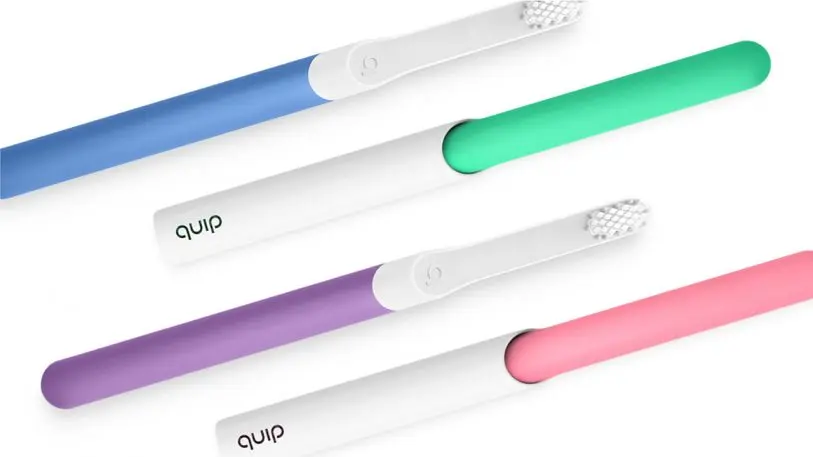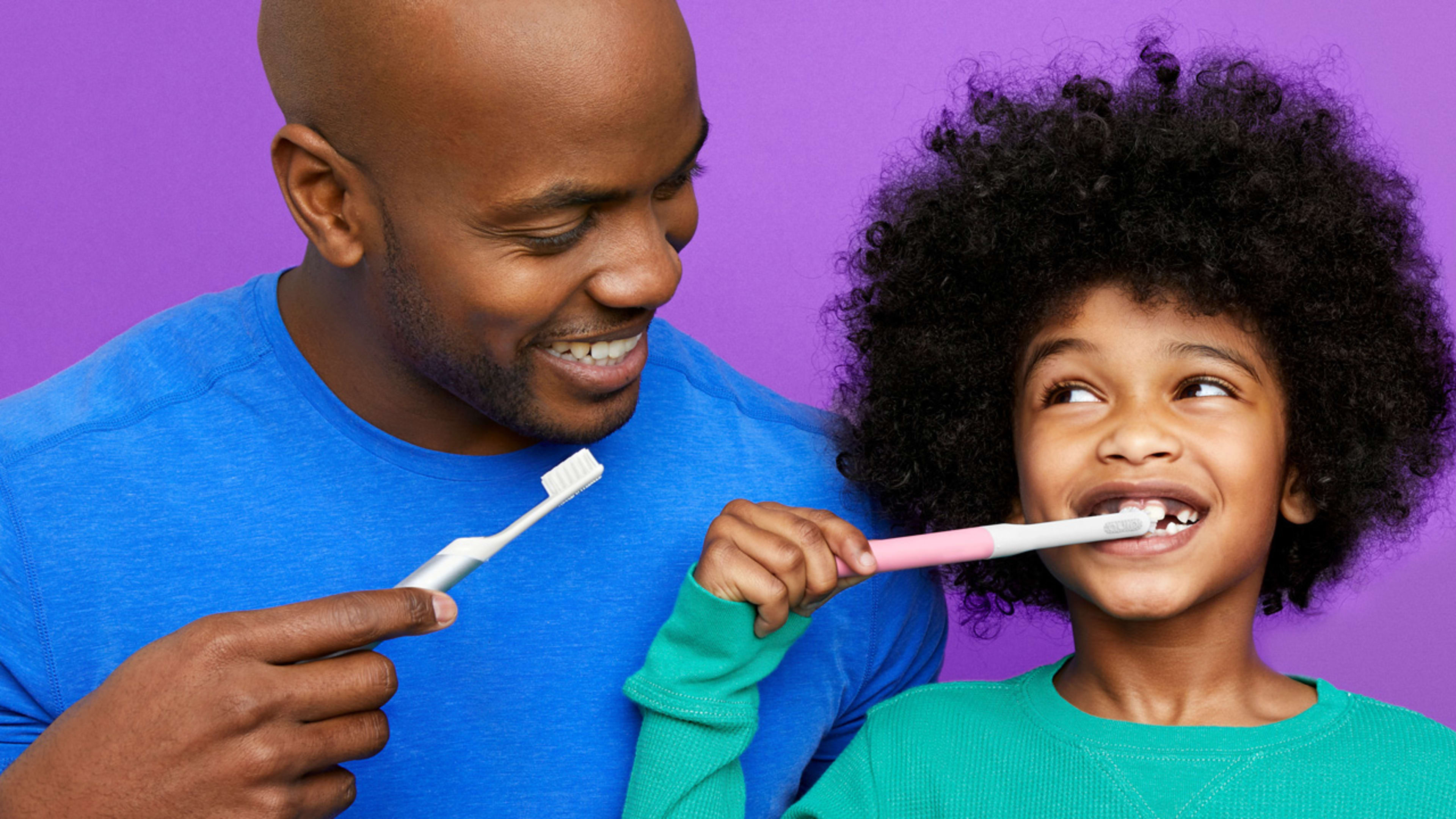This week, Quip, the four-year-old electric toothbrush startup, launched a children’s toothbrush that looks identical to the adult version, only scaled down for smaller hands and mouths. That’s right: It’s a minimalist, design-forward toothbrush that would look at home on a sleek, modern bathroom counter. There are no images of Mickey Mouse, Hello Kitty, or Elmo anywhere.
Quip’s new children’s brushes–which have been approved by the American Dental Association–look like slightly smaller versions of the adult brushes. Unlike the many bulky electric toothbrushes on the market that come with large chargers, Quip is battery-operated, with a slim handle and a wall mount that doubles as a carrying case to protect your brush while traveling. The kids’ brushes come in pink, green, purple, and blue, and with a tube of kid-friendly toothpaste. The brush heads are designed for the mouths of children between the ages of 3 and 12. “We converted the handle to rubber to make it easier for smaller hands to grip, especially when wet or covered in toothpaste,” says Simon Enever, Quip’s founder and CEO. “Throughout our testing, we discovered that kids aren’t big fans of mint-flavored toothpaste, [so] we created a watermelon-flavored anti-cavity toothpaste.”

Quip is part for a broader trend in the hip direct-to-consumer startup world. These brands are coming for your kids. Allbirds launched toddler versions of its sneakers, cleverly called Smallbirds. Away launched kid-size rolling suitcases. And this week, Warby Parker has smaller versions of its glasses, so that you and junior can wear the same frames.
In each case, the child-size product looks identical to the adult versions, just smaller. For design-forward millennial parents who are sick of seeing cartoon characters taking over their house, thanks to their kids’ paraphernalia, this comes as a welcome development. But it also makes very good business sense for these companies: Their target audience is millennials, who are now getting married, buying houses, and having children. It makes sense to sell products to both the parent and their offspring because it increases the potential lifetime value of each customer.

Quip’s kids’ brush functions exactly like the adult version, with a battery that causes it to vibrate gently for two minutes, with signals every 30 seconds to let you know that it is time to move to a different part of the mouth. This brush will likely work better for slightly older children who already know how to brush their teeth but have yet to develop healthy routines. According to Enever’s research, brushing habits begin to set in around the age of nine. Quip’s brush will encourage these children to brush every corner of their mouth for the correct amount of time–something that even adults often fail to do. “Fixing bad habits is a challenge, so the most exciting thing about working on a kids’ brush was that we would be helping to form good habits before the bad habits even took hold, meaning we could have a longer lasting impact on oral health,” he says.
My own three-year-old, who is not very comfortable with electric brushes, promptly ran out of the room and hid under her bed when I switched on the toothbrush. She eventually agreed to use it like a regular manual brush, without switching it on. Hopefully, over time, she will acclimate to its vibrations. It’s possible I have a particularly skittish daughter.
Quip, which pitches itself as a more affordable, direct-to-consumer alternative to electric toothbrush brands like Sonicare, has grown quickly since it launched in 2015. The company recently announced that it had sold its one-millionth toothbrush. The brand has also moved beyond its direct-to-consumer model by selling the product at Target stores. With the kids’ line, Quip will be able to further expand its reach. The kids’ brush, along with a tube of kids’ toothpaste, costs $25, which is more expensive than your run-of-the-mill drugstore kids’ toothbrush, which can go for less than $5. And Quip also offers a subscription plan, which will deliver new brush heads and toothpaste every three months.

Enever says the company spent months learning about kids’ dental issues before designing this brush. Quip had heard from many subscribers that they were looking for brushes for their children, so the company reached out to these people and invited them to be part of a testing and prototyping process. The company also reached out to pediatric dentists who had parents in their networks whose kids might be interested in being part of this process. More than 50 children between the age of 3 and 12 took part in three separate “at home” testing periods.
The first round of tests involved how kids used their current toothbrushes, the second involved a prototype that Quip designed, and the final testing involved a refined prototype. Enever says that the company gathered some important insights from these experiments. One was that the biggest challenge among children is that they tend to have an overwhelmingly negative attitude toward brushing. The second was that many kids actually wanted a brush that looked more like their parents’.
“The most immediate and impactful finding during our research happened when we gave kids a brush that looked and felt like the brush the adults in their life were using,” Enever says. “The kids instantly felt empowered and proud to use something that looks and feels like what their parents use, and their attitude toward brushing changed.”
This may be surprising to parents who have found that their kids will literally stop them in a grocery store and coerce them to buy anything with Elmo’s face on it by screaming. But it is also true that many children want to mimic their parents’ behavior. If their parents happen to use the distinct-looking Quip brush, then having one that looks identical to their parents’ may seem like a fun way to act more grown-up.
And let’s not underestimate what a relief it will be for parents to be able to purchase a kids’ brush that does not have an ugly cartoon character on it. There’s nothing like an enormous Hello Kitty face to ruin a perfectly nice bathroom counter.
Recognize your brand’s excellence by applying to this year’s Brands That Matter Awards before the early-rate deadline, May 3.
